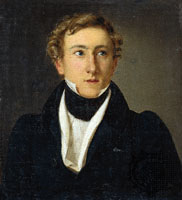August Bournonville facts for kids
Quick facts for kids
August Bournonville
|
|
|---|---|

Portrait of Bournonville by Louis Aumont (1828)
|
|
| Born |
Antoine Auguste Bournonville
21 August 1805 Copenhagen, Denmark
|
| Died | 30 November 1879 (aged 74) Copenhagen, Denmark
|
| Resting place | Asminderød Cemetery, Fredensborg, Denmark |
| Occupation | Ballet Master Choreographer |
| Known for | Bournonville School |
| Spouse(s) | Helena Fredrika Håkansson |
| Children | 6 |
August Bournonville (born August 21, 1805 – died November 30, 1879) was a famous Danish ballet master and choreographer. A ballet master is someone who teaches and directs ballet dancers. A choreographer creates and arranges dance moves. August was the son of Antoine Bournonville, who was also a dancer and choreographer.
August Bournonville was born in Copenhagen, Denmark. He learned ballet from his father and also from Vincenzo Galeotti at the Royal Danish Ballet. He later studied in Paris, France, with the French dancer Auguste Vestris. Bournonville created his own special way of dancing and teaching ballet, which is now called the Bournonville School.
After studying in Paris, Bournonville became a main dancer at the Royal Ballet in Copenhagen. From 1830 to 1848, he was the choreographer for the Royal Danish Ballet. He created more than 50 ballets that were loved for being lively, light, and beautiful. His style was unique, even though he was influenced by the Paris ballet. He made ballets set in many different places, from Denmark to Italy, and even South America. Some of these amazing works are still performed today.
Bournonville's ballets became well-known outside Denmark after World War II. Since the 1950s, The Royal Ballet has toured many times, especially to the United States, where they have shown his wonderful ballets.
Some of Bournonville's most famous ballets include La Sylphide (1836), Napoli (1842), Le Conservatoire (1849), The Kermesse in Bruges (1851), and A Folk Tale (1854).
Early Life and Training
August Bournonville was born in Copenhagen on August 21, 1805. His father, Antoine Bournonville, was a French ballet master who had moved to Denmark. When August was eight years old, he joined the Royal Ballet School. He learned from his father and from Vincenzo Galeotti, who was the main choreographer for the Royal Danish Ballet.
On October 2, 1813, Bournonville danced on stage for the first time. He had a small part in Galeotti's ballet Lagertha. This was the first ballet ever made about a Nordic story. Less than a year later, he got his first applause for a solo dance. Besides dancing, Bournonville loved to read. He learned French at home, played the violin, and sang. He was a very talented young person!
Family Life
August Bournonville had five brothers and sisters. He was the only one of his siblings who became interested in dancing. He married Helena Fredrika Håkansson on June 23, 1830. They had seven children together. One of their daughters, Charlotte Bournonville, became a well-known opera singer and actress.
Studying in Paris
In 1820, August went with his father to Paris, France, to study ballet. Even though he only trained with his father there, he saw the newest and most exciting ballet styles. When he returned to Denmark, he joined the Royal Theatre.
In 1824, Bournonville went back to Paris for more training. He hoped to study with the famous teacher Gardel, but Gardel's studio was closed. So, he went to Auguste Vestris, who helped him improve his balance, turns, and arm movements. Bournonville danced with the famous dancer Marie Taglioni and the Paris Opéra Ballet from 1820 to 1828.
Later Years and Legacy
Bournonville stopped teaching adult ballet classes in 1877. He passed away on November 30, 1879, after returning from church. He was buried in Asminderød Churchyard in Denmark.
Bournonville's work is still very important today because it connects us to older ballet traditions. He made sure that both male and female dancers had equally important roles in his ballets. This was special because, at that time, many European ballets focused mostly on the female ballerina. While other choreographers showed very strong emotions, Bournonville's ballets showed a more balanced human nature, using lively footwork and smooth movements.
See also
 In Spanish: Auguste Bournonville para niños
In Spanish: Auguste Bournonville para niños
- List of ballets by August Bournonville
- Royal Danish Ballet school

